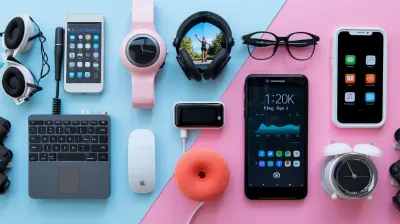Wearable Devices for Sleep Tracking: The Science Behind a Restful Night
15 June 2025
Let’s be honest—most of us aren’t sleeping as well as we should. Whether it's binging Netflix, doomscrolling on social media, or stressing about tomorrow’s to-do list, good sleep often takes a backseat. But what if your gadget could help solve the problem while you slept?
Enter wearable sleep trackers. These snazzy little devices claim to track everything from light vs. deep sleep to heart rates and breathing patterns. Sounds futuristic, right? But what’s the real science behind it all? Can a watch or ring really help you sleep better? Let’s dig into the world of wearable sleep tech and find out how it works, why it matters, and whether it’s worth strapping a device to your wrist every night.![]()
Why Sleep Matters More Than You Think
Before we go deep into the techy stuff, let’s take a moment to understand why sleep is such a big deal.Sleep is like your body’s reset button. Every night, your brain goes through different stages—light sleep, deep sleep, and REM sleep (that’s the dream-heavy one). It’s during these stages that your body repairs itself, processes memories, and balances hormones.
If your sleep’s out of whack, everything feels off. You’re cranky, unfocused, and your immune system can take a hit. Chronic sleep deprivation? That’s linked to serious stuff like heart disease, obesity, and diabetes.
So yeah, sleep’s not just some luxury—it’s absolutely essential.![]()
What Are Wearable Sleep Trackers Anyway?
Okay, picture this. You’re wearing a smartwatch, a fitness band, or maybe a sleek-looking ring. You go to bed, doze off, and while you’re off wandering dreamland, your little sidekick monitors your body.Wearable sleep trackers are devices designed to analyze your sleep patterns, mostly using sensors that detect movement (actigraphy), heart rate (HR), heart rate variability (HRV), skin temperature, and sometimes even blood oxygen levels (SpO2).
They’re like sleep spies... except helpful.
Common Types of Wearable Sleep Trackers:
- Smartwatches (Apple Watch, Galaxy Watch)- Fitness bands (Fitbit, Xiaomi Mi Band)
- Smart rings (Oura Ring)
- Sleep headbands (Muse S, Dreem Band)
Each type comes with different sensor configurations, but the goal is the same: figure out how well (or poorly) you’re sleeping.![]()
How Do These Devices Track Sleep?
Magic? Not quite. But close.Most wearables use a combo of accelerometers (to detect movement) and optical sensors (to measure pulse through your skin) to guess when you’re asleep and what stage you’re in.
Here’s the breakdown:
- Stage Detection: By analyzing your movement and physiological signals like heart rate dips and breathing rates, the device estimates whether you’re in light, deep, or REM sleep.- Heart Rate Variability (HRV): Your heart doesn’t beat like a metronome—it varies slightly between beats. Changes in HRV can indicate stress levels and sleep quality, and some wearables use this to refine their algorithms.
- Blood Oxygen Monitoring: Some trackers can detect oxygen saturation (SpO2). This is super helpful for identifying sleep apnea or breathing irregularities during sleep.
- Skin Temperature & Respiration: A few devices measure body temperature and breathing rates to offer even more personalized sleep insights.
In essence, these devices are like sleep detectives using your body's subtle clues to reconstruct your nighttime adventures.![]()
The Science Behind the Sensors
Let’s geek out for a second.Most wearables rely on a technique called photoplethysmography (PPG). It’s a mouthful, but it basically involves shining a light through your skin and measuring how much light is absorbed or reflected. Because blood absorbs light, this lets the sensor figure out your heart rate.
Combined with motion data from accelerometers, the device notices when you’re tossing and turning or lying still, syncing it with your heart rhythm and breathing. Then, using machine learning (yep, AI’s busy in the background), it classifies what sleep stage you’re likely in.
Now, is it 100% accurate? Nope. But many high-end wearables come impressively close when compared to polysomnography—the gold standard sleep test done in labs.
Are These Devices Actually Accurate?
Okay, this is the million-dollar question. Can you trust a wearable more than your own groggy morning brain?Studies show that modern wearables can be pretty accurate at detecting total sleep time and sleep onset (when you fall asleep). On the flip side, they often struggle to nail down sleep stages with perfect precision.
Here’s the thing: unless you’re in a sleep lab hooked up to dozens of wires, no method is fully accurate. But for everyday folks trying to improve sleep habits, these devices offer valuable insights.
Think of it this way: Your device won’t give you clinical-level data, but it will paint a picture—one that’s good enough to spot trends, patterns, and possible problems.
The Benefits of Using a Sleep Tracker
Why even bother tracking your sleep? Isn’t ignorance bliss?Well, staying in the dark about your sleep won’t fix poor rest. Tracking can shine a light (pun intended) on what’s really happening each night.
Here’s how a wearable can help:
- Spot Bad Habits: You might think you’re going to bed early, but your tracker may reveal late bedtimes or restless nights.- Personalized Data: Patterns over weeks can show how caffeine, alcohol, or stress affects your sleep.
- Better Routines: Seeing your sleep trends can help you fine-tune your wind-down rituals.
- Motivation Boost: Just like fitness trackers make you walk more, sleep trackers can motivate better sleep hygiene.
- Health Monitoring: Advanced trackers can signal if something’s off—like irregular heart rates or potential sleep apnea symptoms.
It’s like having a mini sleep coach on your wrist.
Limitations to Keep in Mind
Of course, no gadget is perfect. While wearables are cool and often helpful, they do come with caveats.- Over-reliance Can Backfire: Some people get too obsessed with their sleep scores, leading to orthosomnia—a real condition where the pursuit of perfect sleep causes insomnia. Irony, much?
- Privacy Concerns: You’re handing over sensitive health data. Make sure the brand has solid privacy policies.
- Battery Life & Comfort: Wearing a device all night isn’t everyone’s cup of tea. Some wearables are bulky or need frequent charging.
- Data Interpretation: Not all feedback is straightforward. You might need to interpret the insights or even talk to a health professional.
Don’t treat your wearable as the end-all-be-all. It’s a tool, not a diagnosis.
Popular Sleep Trackers Worth Checking Out
Let’s look at some big names in the sleep-tracking game and what sets them apart.1. Oura Ring
A stylish, lightweight ring that tracks sleep stages, heart rate, body temp, and even readiness scores. Minimalist yet powerful.2. Fitbit Sense & Fitbit Charge
Fitbit’s been in the game for years. Great sleep-tracking features with easy-to-understand graphs and personalized advice.3. Whoop Strap
Targets athletes and performance-minded folks. Focuses on recovery and strain, with deep sleep metrics.4. Apple Watch
With its native Sleep app and third-party plugins, Apple Watch provides solid sleep tracking—especially when combined with iPhone Health data.5. Garmin Devices
Garmin’s trackers offer highly detailed analysis and are a favorite among fitness buffs.Each has its pros and cons. It boils down to what you value—design, battery life, metrics, or app quality.
Tips to Get the Most Out of Your Sleep Tracker
Want to amp up your sleep game? Here are a few pro tips:1. Wear it Consistently: Don’t skip nights. The more data, the better the insights.
2. Stick to a Sleep Schedule: Sleep tracking is more useful when your habits are consistent.
3. Use the Data Wisely: Take note of patterns, but don’t stress over occasional bad nights.
4. Combine With a Sleep Journal: Jot down mood, caffeine intake, and stress levels during the day to correlate with sleep data.
5. Update Firmware: Yeah, it’s boring. But updates often improve tracking algorithms.
Where Tech Meets Wellness
The beauty of wearable sleep trackers is that they bridge the gap between technology and personal health. They’re not just wearables—they’re whispering sleep coaches, giving us a little nudge to take better care of ourselves.Instead of stumbling through the day groggy and yawning, why not use that tech on your wrist or finger to understand your body better? With the right insights, you can make small tweaks that add up to big improvements in how you rest.
After all, sleep isn’t just about quantity—it’s about quality. And who knows? With a little help from some circuit boards and sensors, your best night’s sleep might just be a tap away.
Final Thoughts
Wearable devices for sleep tracking are more than just trendy tech—they’re useful tools in the pursuit of better health. While they’re not flawless sleep scientists, they offer an accessible way to monitor, understand, and improve your nightly rest.So, the next time you hit the hay with a tracker strapped on, think of it as inviting a tiny data-driven sidekick to help you conquer the land of dreams.
Sleep tight!
all images in this post were generated using AI tools
Category:
Wearable TechAuthor:

Vincent Hubbard
Discussion
rate this article
3 comments
Jasmine Collins
Wearable sleep trackers offer a fascinating glimpse into our nightly rhythms, blending technology with biology. However, as we rely on data to optimize rest, we must consider the balance between quantifiable insights and the subjective nature of sleep. Can data-driven insights enhance our understanding, or do they risk oversimplifying our complex needs for rest?
June 22, 2025 at 12:08 PM

Vincent Hubbard
Thank you for your thoughtful comment! While data can provide valuable insights into sleep patterns, it’s essential to remember that individual experiences and needs vary greatly. Balancing quantitative data with personal intuition can lead to a more holistic understanding of sleep.
Nell Weber
Great insights! Sleep tracking wearables are fascinating, blending technology with health science to enhance our rest. Understanding our sleep patterns can truly transform our well-being. I'm excited to see how these devices evolve and help us achieve better sleep quality. Thanks for sharing such valuable information!
June 21, 2025 at 2:53 AM

Vincent Hubbard
Thank you for your feedback! I'm glad you found the insights valuable. The evolution of sleep tracking wearables is indeed exciting and holds great potential for improving our well-being.
Sophia McGovern
Ah, the magic of wearable devices that promise the perfect night’s sleep! Who needs a cozy blanket and a good book when you can strap on a gadget that tracks your every toss and turn? Because, clearly, knowing you snore is the real path to restful slumber!
June 20, 2025 at 4:39 AM

Vincent Hubbard
While wearable devices offer insights into sleep patterns, nothing beats the comfort of a cozy blanket and a good book. They’re just tools to help us understand our sleep better!



